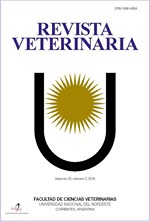Age, sex, year season, and handling system modify the leukocytal parameters from captive Caiman latirostris and Caiman yacare (Crocodylia: Alligatoridae)
DOI:
https://doi.org/10.30972/vet.1711963Keywords:
Caiman latirostris, Caiman yacare, leukocyte concentration, differential count, physiological variations.Abstract
The purpose of the study was to establish the reference interval for blood leukocytes
from captive northeastern Argentine caimans, as well as to detect physiological variations
related to species, sex, age, year season, and handling system. Samples from 223 healthy
sub–adults, both sexes specimens of Caiman latirostris (n = 109) and Caiman yacare (n =
114), were obtained. White blood cells concentration (13.7±2.5 G/l) and proportion of heterophils
(17.5±3.4%), lymphocytes (75.0±6.8%), monocytes (5.3±1.1%), eosinophils (2.2±0.4%),
and basophils (0.3±0.05%) were determined by reptilian specific techniques. For each type of
cell, largest diameters were, respectively: 14.49±1.54; 8.70±1.01; 12.74±1.85; 12.55±2.15 and
10.77±1.02 um. Heterophils rate was significantly higher in C. yacare than in C. latirostris (p
< 0.05); lymphocytes rate showed an inverse relationship between species. Lymphocytes proportion
was significantly higher in females than in males. The growth progress was reflected
in slight heterophils decrease and lymphocytes increase. Total leukocytes concentration and
lymphocytes percentage were significantly lower in autumn and winter. Decreases of heterophils
(not significant) and monocytes (significant) were registered in summer and spring.
Greater leukocytal differences attributable to handling systems (housing, feeding) used in
a hatchery and a zoo, were not verified. Obtained data are applicable for the diagnosis and
prevention of diseases in these species.
Downloads
Downloads
Published
How to Cite
Issue
Section
License
Revista Veterinaria (Rev. Vet.) maintains a commitment to the policies of Open Access to scientific information, as it considers that both scientific publications as well as research investigations funded by public resources should circulate freely without restrictions. Revista Veterinaria (Rev. Vet.) ratifies the Open Access model in which scientific publications are made freely available at no cost online.










.jpg)
.jpg)



